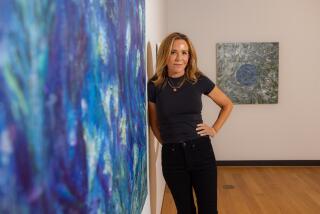ART REVIEW : Two Views of the ‘Revival’ of the Abstract
SANTA BARBARA — It’s tempting to say that two exhibitions, “Abstract Options” at the University Art Museum, UC Santa Barbara, and “Joan Snyder Collects Joan Snyder” at the Contemporary Arts Forum, jointly declare the revival of abstract painting. But the notion doesn’t hold much water.
For one thing, you need more than a temporary disappearance to have a revival. Abstraction didn’t die when Neo-Expressionism arrived; it only surrendered the limelight and it has maintained a loyal following.
For another, the university’s show blurs boundaries between representation and abstraction, while Joan Snyder’s incorporates figurative images and is overtly autobiographical.
She became known in the late ‘60s for rather cool-looking “stroke” paintings (bleeding-edge horizontal stripes on canvas), but Snyder has always poured body and soul into her work. A 1964 abstraction called “Grandma Cohen’s Funeral Painting” resembles a roiling landscape and has a tiny Jewish star incised in a dark area.
In a 1972-73 piece called “Flesh/Art,” cuts in the canvas resemble wounds or orifices in a weathered “skin” of pigment. Each section of a 1972 grid of multicolored squares has its own character: gritty, vulnerable, darkly ominous or effusive.
More recently, in works such as “Trilogy,” the New York artist has painted images of figures, primitive houses, trees and mountains in geometric frameworks and tacked on bunches of plastic grapes to symbolize life and passion. “An Offering for Pro,” painted as a memorial to artist Porfirio Didonna, portrays Snyder as a grieving nude at the base of a tree. A distressing recent work features a photograph of a starving African boy.
There’s a frankly feminist edge to her work beginning in the mid-’70s. One minute the paintings are like ripe fruits or fertile landscapes, the next they are joyous celebrations or raw nerves. Affected by her divorce, friends’ sorrows and news reports of human atrocities, Snyder’s work can be messy, childlike, almost vulgar. It is always intensely emotional. When images aren’t up to conveying the fullness of her feelings, she writes her thoughts across her paintings.
Little wonder, then, that Snyder has great difficulty parting with her work. Paintings tend to mark important moments in her life: births, deaths, the beginnings and ends of relationships. To sell the art is to part with crucial, if sometimes painful, experiences.
She does sell her work through galleries, but the 36 paintings in the show, organized by Contemporary Arts Forum Director Betty Klausner, were selected from the artist’s extensive personal collection. Not surprisingly, they present themselves as the quintessential Joan Snyder.
Compared with Snyder’s art, the 30 paintings in “Abstract Options” appear austere, but they are neither coldly mechanistic nor purely self-referential. The artist’s hand is present in James Hayward’s swirling, solid-color impastoes, Paul Morgensen’s richly veiled geometric structures and in the homely overlays of Mary Heilman’s imperfectly angled paths and borders. Even John M. Miller’s precise, diagonal rows of tilted lines are subtly varied in color.
Observers of this show need not feel like philistines if they note that Julian Lethbridge’s paintings resemble webbing and stone patterns or that Nancy Haynes’ gestural canvases refer to landscapes and, in one case, a cruciform. When Moira Dryer boldly titles a gold-and white-striped painting “K Mart,” she suggests that the pattern was borrowed from discount-store merchandise and that a circle in the center might be the imprint of a messy paint can.
These artists don’t protect abstraction from human experience. And they certainly don’t go along with Neo Geo cynics who argue that art’s only remaining role is to lecture about its own impotence. The 10 artists in “Abstract Options” are relatively old-fashioned, even a bit romantic in their apparent conviction that abstraction can touch the soul.
The newness of their work is that it consciously deals with “impure form” or “a balance between the purity of form and the reality of chaos,” as Phyllis Plous notes in her catalogue essay. This is not the product of fuzzy thinking, more the result of ‘70s “pluralism,” which fostered tolerance toward the coexistence of many styles. Plous and co-curator Frances Colpitt have recognized this development and organized an intelligent think-piece on current abstraction.
Both exhibitions will travel to two additional cities. “Joan Snyder Collects Joan Snyder,” at the Contemporary Arts Forum to Feb. 11, will go to Santa Clara University (June 25-Aug. 20) and Sonoma State University (Sept. 14-Oct. 29). “Abstract Options,” at the University Art Museum to Feb. 26, is booked at Northwestern University, in Evanston, Ill. (April 4-June 18) and the University of Santa Clara (July 9-Sept. 3).
More to Read
The biggest entertainment stories
Get our big stories about Hollywood, film, television, music, arts, culture and more right in your inbox as soon as they publish.
You may occasionally receive promotional content from the Los Angeles Times.










